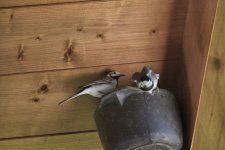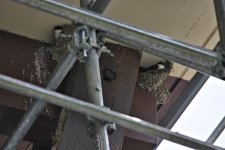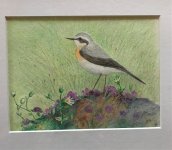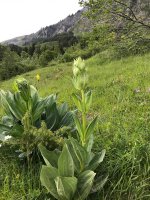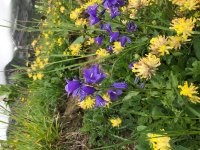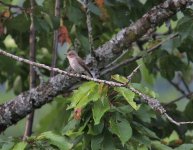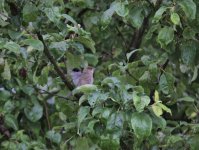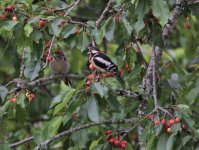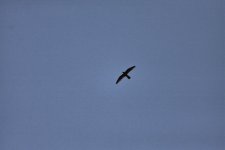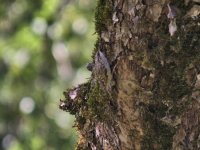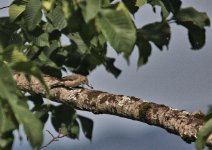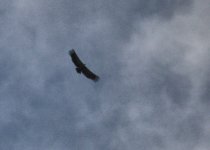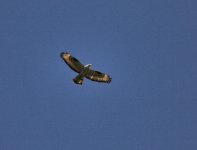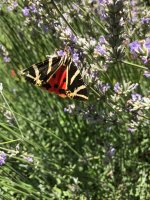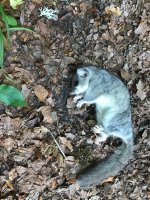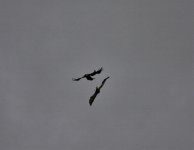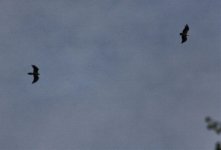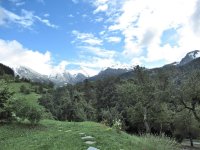Richard Prior
Halfway up an Alp

More arrivals
30 May The LPO have asked me to keep a discreet eye on some House Martin nests just up the road from home at the Col de la Croix Fry, the building they nest on each year is being redecorated inside and out and the architect had indicated that two nests were on a wall that is to be demolished but promised to wait until the young fledge before proceeding. I had a look on Saturday when no work takes place and found two pairs finishing building the nests which seemed to have suffered some damage (hard to tell when though). Nearby was a very agitated Fieldfare so surely breeding I thought, and a displaying Serin.
Just 2kms further is a second Col, Merdassier where there are some nice damp, weedy areas where I’ve seen Whinchat breeding in the past, so I popped along to check it out. Quite a surprise when the chat singing from the wires at the usual site turned out to be a Stonechat, at over 1400m altitude this is very unusual, they don’t breed that high up in our region. Another surprise, I could hear a Quail ‘witt te witting’ on the other side of the road. This is a species that’s in decline at lower altitude but increasingly breeding higher up nowadays, even up to 1800m. It’s my first one within the Manigod commune boundaries though, unsurprisingly it remained unseen by me. Two or three male Whinchat were singing between this spot and the car park at the ski resort, I tried to photo one on a tree but it flew off, at that moment I heard a buzzing on the wind, reminiscent of a juv Starling, the sound was coming from a patch of enormous rhubarb - like leaves on a bank across a ditch 50m away. As I got closer I realised that the buzzing was the only part of a very varied song that I had been able to hear at that distance, closer up it was clear I’d found a Marsh Warbler, blimey, another ‘Manigod tick’ :t: Like an arthritic Chamois I jumped gracefully ( ) over the ditch and crept up the bank, luckily coming up right behind the songster that very kindly shuffled along the edge of a giant leaf to turn and sing right at me, even my rudimentary photographic skills couldn’t prevent me missing this one!
) over the ditch and crept up the bank, luckily coming up right behind the songster that very kindly shuffled along the edge of a giant leaf to turn and sing right at me, even my rudimentary photographic skills couldn’t prevent me missing this one!
June 1 and 2 saw us doing gardening and maintenance work up at Les Frasses again and finally the Common Crossbill were back, a good flock of c60 flew over what is normally a regular place to see them year round, it was August 2019 since I’d seen any in Haute Savoie and looking at the LPO database for the département I see that they have indeed been very scarce. The first day a very young Black Redstart was hopping around our feet by the building, no adults or other young to be seen, it seemed to be waiting for parents to bring food, couldn’t really fly more than a few metres but after an hour it caught an ant, then another so we assumed it would manage for itself. Next morning I found it had died so I wonder whether we should have brought it home and released near the young of the same age that were around our house in the hope of an adoption by the local adults. Not sure whether they would have accepted a strange juv or not but perhaps it would have been worth a try. Willow Tit and a singing Bonelli’s Warbler up there were good to hear too.
A Bonelli’s was also singing about 500m from home on 7th as was a Tree Pipit, I’m sure I hadn’t overlooked them in recent weeks so either late arrivals or displaced by the change to wet and cool conditions, a Red Kite was a nice surprise on the slopes north of us, presumably breeding not far away. When the rain stopped 3 Crag Martins appeared and an adult male Peregrine whooshed over, my first June sighting here in 4 years’ watching, I’ve still to see a female and I suspect the breeding site is a good 5kms away near where we saw a juv female one summer.
8 June I actually left Haute Savoie for the first time since 14 Feb :eek!:as we went over the Col des Aravis and all of 2kms into Savoie for a morning walk before the forecast heavy rain arrived. It was, let’s say, ‘bracing’ and overcast after the first hour so the camera stayed in my rucksack throughout as we walked briskly to keep warm. On the higher parts (c 1600m) there were plenty of Whinchat, Red-backed Shrike, Northern Wheatear, Linnet Yellowhammer and Tree Pipit about plus Kestrel, Buzzard and Cuckoo, the last mentioned sounding a bit garbled at times. The more wooded areas had lots of Blackcap, singing Dunnock, Chiffchaff and a couple of Garden Warbler. Getting back to the car as the rain started we retreated back up to the Col and had a meal out for the first time since January, so much for the life of frequent French fine dining I imagine I’d be living in my retirement! It was only 7°C so the rest of the birding was from the car as the rain poured down, apart from a check on the House Martins’ nests and I was delighted to see a recently fledged Fieldfare being fed by an adult, a first for me here in Manigod. Amazingly at the Merdassier site there was now a female Stonechat as well as the male present and despite the temperature the Marsh Warbler was still singing and visible for my wife to admire (she already is thinking of doing a watercolour of the warbler and by the end of the day had done a very nice (I am a bit biased of course) painting of a Wheatear we’d seen during the morning.
June 9 to 12 Cool and wet throughout, the ornithological birding entertainment provided by a) our neighbours’ cherry tree which has proved a bird magnet this year, my only disappointment being that it didn’t pull in any passing Rosy Starling(!) and b) the antics of the White Wagtail couple that chose to nest in the old saucepan I had installed under the eaves of our patio. It’s an excellent year for all fruit by the looks of it, and the heavily laden cherry tree has had 13 different species feeding on it , topped off by a magnificent male Black Woodpecker at dusk on 12th, earlier in the evening two Alpine Swift were a welcome sight and a Common Crossbill flew over unseen (by me at least). The White Wagtail adults have been brilliant parents, sharing the egg brooding as well as all the feeding duties, they fledged five young, one managed to kill itself against a window on leaving the nest, so we kept the shutters closed for the next 36 hours until the last juv left the nest, so 4 out of 5 isn’t bad, a big flock of sheep with their lambs nearby guaranteed an easily accessed and plentiful food supply.
Photos: Marsh Warbler, White Wagtail parents, House Martins’ nests, Wheatear art and a popular perch for Whinchat (Yellow Gentian).
30 May The LPO have asked me to keep a discreet eye on some House Martin nests just up the road from home at the Col de la Croix Fry, the building they nest on each year is being redecorated inside and out and the architect had indicated that two nests were on a wall that is to be demolished but promised to wait until the young fledge before proceeding. I had a look on Saturday when no work takes place and found two pairs finishing building the nests which seemed to have suffered some damage (hard to tell when though). Nearby was a very agitated Fieldfare so surely breeding I thought, and a displaying Serin.
Just 2kms further is a second Col, Merdassier where there are some nice damp, weedy areas where I’ve seen Whinchat breeding in the past, so I popped along to check it out. Quite a surprise when the chat singing from the wires at the usual site turned out to be a Stonechat, at over 1400m altitude this is very unusual, they don’t breed that high up in our region. Another surprise, I could hear a Quail ‘witt te witting’ on the other side of the road. This is a species that’s in decline at lower altitude but increasingly breeding higher up nowadays, even up to 1800m. It’s my first one within the Manigod commune boundaries though, unsurprisingly it remained unseen by me. Two or three male Whinchat were singing between this spot and the car park at the ski resort, I tried to photo one on a tree but it flew off, at that moment I heard a buzzing on the wind, reminiscent of a juv Starling, the sound was coming from a patch of enormous rhubarb - like leaves on a bank across a ditch 50m away. As I got closer I realised that the buzzing was the only part of a very varied song that I had been able to hear at that distance, closer up it was clear I’d found a Marsh Warbler, blimey, another ‘Manigod tick’ :t: Like an arthritic Chamois I jumped gracefully (
June 1 and 2 saw us doing gardening and maintenance work up at Les Frasses again and finally the Common Crossbill were back, a good flock of c60 flew over what is normally a regular place to see them year round, it was August 2019 since I’d seen any in Haute Savoie and looking at the LPO database for the département I see that they have indeed been very scarce. The first day a very young Black Redstart was hopping around our feet by the building, no adults or other young to be seen, it seemed to be waiting for parents to bring food, couldn’t really fly more than a few metres but after an hour it caught an ant, then another so we assumed it would manage for itself. Next morning I found it had died so I wonder whether we should have brought it home and released near the young of the same age that were around our house in the hope of an adoption by the local adults. Not sure whether they would have accepted a strange juv or not but perhaps it would have been worth a try. Willow Tit and a singing Bonelli’s Warbler up there were good to hear too.
A Bonelli’s was also singing about 500m from home on 7th as was a Tree Pipit, I’m sure I hadn’t overlooked them in recent weeks so either late arrivals or displaced by the change to wet and cool conditions, a Red Kite was a nice surprise on the slopes north of us, presumably breeding not far away. When the rain stopped 3 Crag Martins appeared and an adult male Peregrine whooshed over, my first June sighting here in 4 years’ watching, I’ve still to see a female and I suspect the breeding site is a good 5kms away near where we saw a juv female one summer.
8 June I actually left Haute Savoie for the first time since 14 Feb :eek!:as we went over the Col des Aravis and all of 2kms into Savoie for a morning walk before the forecast heavy rain arrived. It was, let’s say, ‘bracing’ and overcast after the first hour so the camera stayed in my rucksack throughout as we walked briskly to keep warm. On the higher parts (c 1600m) there were plenty of Whinchat, Red-backed Shrike, Northern Wheatear, Linnet Yellowhammer and Tree Pipit about plus Kestrel, Buzzard and Cuckoo, the last mentioned sounding a bit garbled at times. The more wooded areas had lots of Blackcap, singing Dunnock, Chiffchaff and a couple of Garden Warbler. Getting back to the car as the rain started we retreated back up to the Col and had a meal out for the first time since January, so much for the life of frequent French fine dining I imagine I’d be living in my retirement! It was only 7°C so the rest of the birding was from the car as the rain poured down, apart from a check on the House Martins’ nests and I was delighted to see a recently fledged Fieldfare being fed by an adult, a first for me here in Manigod. Amazingly at the Merdassier site there was now a female Stonechat as well as the male present and despite the temperature the Marsh Warbler was still singing and visible for my wife to admire (she already is thinking of doing a watercolour of the warbler and by the end of the day had done a very nice (I am a bit biased of course) painting of a Wheatear we’d seen during the morning.
June 9 to 12 Cool and wet throughout, the ornithological birding entertainment provided by a) our neighbours’ cherry tree which has proved a bird magnet this year, my only disappointment being that it didn’t pull in any passing Rosy Starling(!) and b) the antics of the White Wagtail couple that chose to nest in the old saucepan I had installed under the eaves of our patio. It’s an excellent year for all fruit by the looks of it, and the heavily laden cherry tree has had 13 different species feeding on it , topped off by a magnificent male Black Woodpecker at dusk on 12th, earlier in the evening two Alpine Swift were a welcome sight and a Common Crossbill flew over unseen (by me at least). The White Wagtail adults have been brilliant parents, sharing the egg brooding as well as all the feeding duties, they fledged five young, one managed to kill itself against a window on leaving the nest, so we kept the shutters closed for the next 36 hours until the last juv left the nest, so 4 out of 5 isn’t bad, a big flock of sheep with their lambs nearby guaranteed an easily accessed and plentiful food supply.
Photos: Marsh Warbler, White Wagtail parents, House Martins’ nests, Wheatear art and a popular perch for Whinchat (Yellow Gentian).





